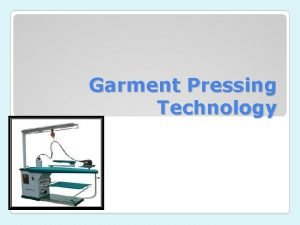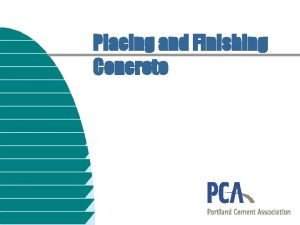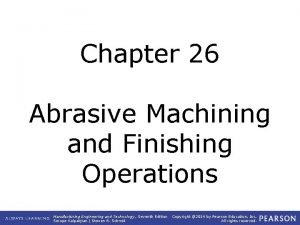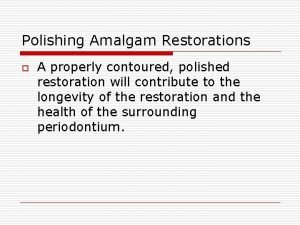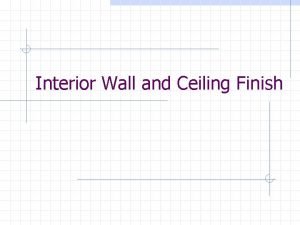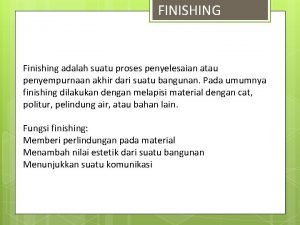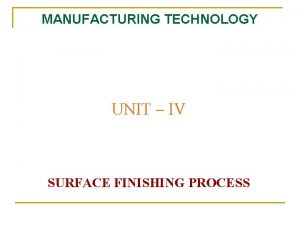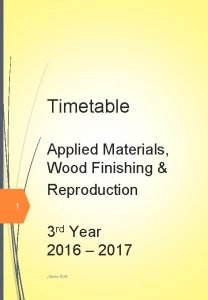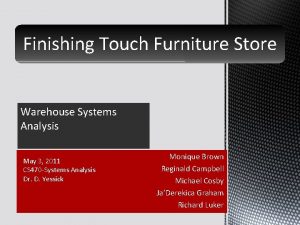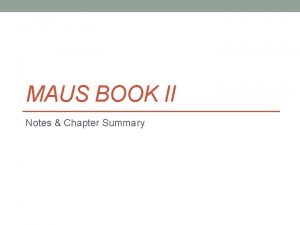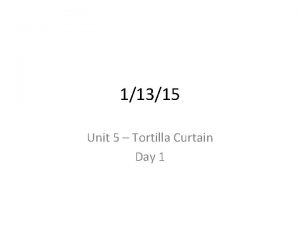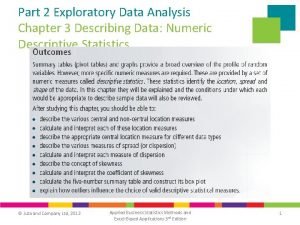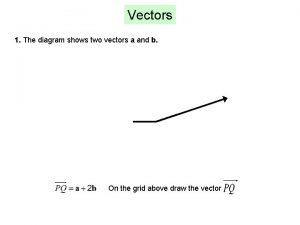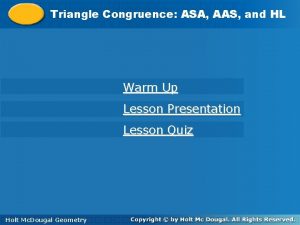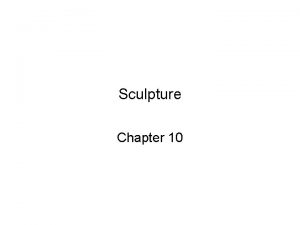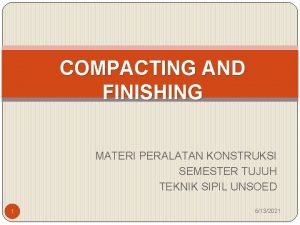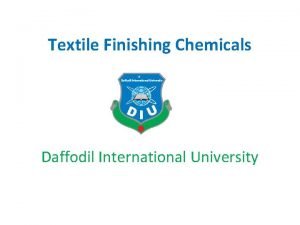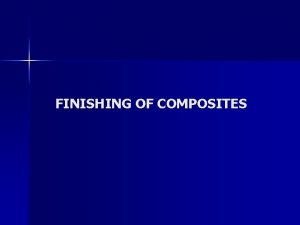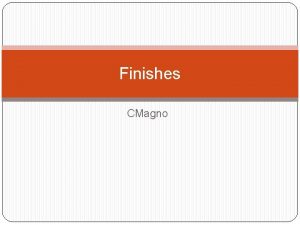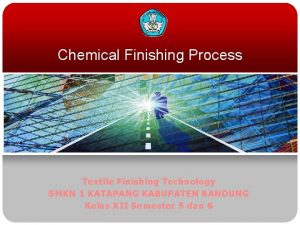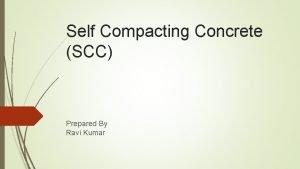Chapter 5 Compacting and Finishing Part 1 CE






































![FIGURE 5 -5: Vibratory tamping foot compactor. [Courtesy of BOMAG (USA)] CE 417 King FIGURE 5 -5: Vibratory tamping foot compactor. [Courtesy of BOMAG (USA)] CE 417 King](https://slidetodoc.com/presentation_image/abae6d38323b1198a7142f1f661d7340/image-39.jpg)


















- Slides: 57

Chapter 5 Compacting and Finishing Part 1 CE 417 King Saud University 1

5 -1 PRINCIPLES OF COMPACTION • • The Compaction Process Optimum Moisture Content Compaction Specifications Measuring Field Density CE 417 King Saud University 2

The Compaction Process • Compaction: – is the process of increasing the density of a soil by mechanically forcing the soil particles closer together, thereby expelling air from the void spaces in the soil. – It should not be confused with consolidation, • Consolidation: – is an increase in soil density of a cohesive soil resulting from the expulsion of water from the soil's void spaces. – Consolidation may require months or years to complete, whereas compaction is accomplished in a matter of hours. CE 417 King Saud University 3

The Compaction Process • Compaction has been employed for centuries to improve the engineering properties of soil. • Improvements include: – increased bearing strength, – reduced compressibility, – improved volume-change characteristics, and – reduced permeability. CE 417 King Saud University 4

The Compaction Process • the equipment and methods employed for compaction in building construction are usually somewhat different from those employed in heavy and highway construction because of: – the limited differential settlement that can be tolerated by a building foundation, – the necessity for working in confined areas close to structures, and – the smaller quantity of earthwork involved. CE 417 King Saud University 5

The Compaction Process • The degree of compaction may be achieved in a particular soil depends on: – the soil's physical and chemical properties (see Chapter 2), – the soil's moisture content, – the compaction method employed, – the amount of compactive effort, and – the thickness of the soil layer being compacted (lift thickness). CE 417 King Saud University 6

The Compaction Process • The four basic compaction forces are: – static weight, – manipulation (or kneading), – impact, and – vibration. CE 417 King Saud University 7

The Compaction Process • Although all compactors utilize static weight to achieve compaction, most compactors combine this with one or more of the other compaction forces. – For example, a plate vibrator combines static weight with vibration. • Manipulation of soil under pressure to produce compaction is most effective in plastic soils. CE 417 King Saud University 8

The Compaction Process • The forces involved in impact and vibration are similar except for their frequency. – Impact or tamping involves blows delivered at low frequencies: • usually about 10 cycles per second (Hz), • It is most effective in plastic soils. – Vibration involves higher frequencies: • may extend to 80 cycles per second (Hz) or more. • Vibration is particularly effective in compaction of cohesionless soils such as sand gravel. CE 417 King Saud University 9

The Compaction Process • The selection and employment of compaction equipment is discussed in Section 5 -2. CE 417 King Saud University 10

Optimum Moisture Content • Soil moisture content: – is one of the five factors influencing compaction results – it is a very important one. • A standard laboratory test – It is called a Proctor test – It has been developed to evaluate a soil's moisture density relationship under a specified compaction effort. – There are two Proctor tests which are: • Standard Proctor Test (ASTM D 698, AASHTO T-99) and • Modified Proctor Test (ASTM D 1557, AASHTO T-180). – Characteristics of these two tests are given in Table 5 -1. CE 417 King Saud University 11

TABLE 5 -1: Characteristics of Proctor compaction tests CE 417 King Saud University 12

Optimum Moisture Content • The modified test: – It was developed for use where high design loads are involved (such as airport runways), – the compactive effort for the modified test is more than four times as great as for the standard test. CE 417 King Saud University 13

Optimum Moisture Content • To determine the maximum density of a soil using Proctor test procedures, compaction tests are performed over a range of soil moisture contents (see Figure 5 -1). • The peak of each curve represents the maximum density obtained under the compactive effort supplied by the test. CE 417 King Saud University 14

FIGURE 5 -1: Typical compaction test results. CE 417 King Saud University 15

Optimum Moisture Content • Comments on Figure 5 -1 are: – maximum density achieved under the greater compactive effort of the modified test is higher than the density achieved in the standard test. – the line labeled "zero air voids“ represents the maximum possible soil density for any specified water content. CE 417 King Saud University 16

Optimum Moisture Content – optimum moisture content of a soil is the moisture content at which maximum dry density is achieved under a specific compaction effort. • 20% for Standard Proctor Test. • 15% for the modified test. – This relationship is typical for most soils where soil's optimum moisture content decreases as the compactive effort is increased. • The line of optimum moisture contents demonstrates that. CE 417 King Saud University 17

Optimum Moisture Content • The importance of soil moisture content to field compaction practice can be demonstrated using Figure 5 -1. – Suppose that specifications require a density of 100 lb/cu ft (1. 6 g/cm 3) for this soil and – the compactive effort being used is equal to that of the Standard Proctor Test. – From Figure 5 -1 it can be seen that the required density may be achieved at any moisture content between 13 and 24%. – a density of 105 lb/cu ft (1. 68 glcm 3) can only be achieved at a moisture content of 20%. CE 417 King Saud University 18

FIGURE 5 -2: Modified Proctor Test results for various soils. (Courtesy of Dr. Harvey E. Wahls) CE 417 King Saud University 19

Compaction Specifications • Compaction specifications are intended to ensure that the compacted material provides the required engineering properties and a satisfactory level of uniformity by: – prescribing the characteristics of the material to be used and – a minimum dry density to be achieved. • The Proctor test is widely used for expressing the minimum density requirement. – The specification will state that a certain percentage of Standard Proctor or Modified Proctor density must be obtained. CE 417 King Saud University 20

Compaction Specifications • As in an example, the soil of Figure 5 -1, – 100% of Standard Proctor density corresponds to a dry density of 105 lb/cu ft (1. 68 glcm 3). – Thus a specification requirement for 95% of Standard Proctor density corresponds to a minimum dry density of 99. 8 lb/cu ft (1. 60 g/cm 3). CE 417 King Saud University 21

Compaction Specifications • Typical density requirements range from 90% of Standard Proctor to 100% of Modified Proctor. For example, – 95% of Standard Proctor is often specified for embankments, dams, and backfills. – 90% of Modified Proctor might be used as requirement for the support of floor slabs. – 95 to 100% of Modified Proctor are commonly used as requirement for the support of structures and for pavement base courses where high wheel loads are expected. CE 417 King Saud University 22

Compaction Specifications • A lack of uniformity in compaction may result in: – differential settlement of structures or – may produce a bump or depression in pavements. • it is important that uniform compaction be obtained. • Uniformity is commonly controlled by specifying a maximum variation of density between adjacent areas. CE 417 King Saud University 23

Compaction Specifications • Compaction specifications may range from: – performance specifications in which only a minimum dry density is prescribed to – method specifications that prescribe the exact equipment and procedures to be used. • (See Section 18 -4 for a discussion of specifications. ) CE 417 King Saud University 24

Measuring Field Density • To verify the adequacy of compaction, the soil density actually obtained in the field must be measured and compared with the specified soil density. • The methods available for performing in-place density tests include: – a number of traditional methods (liquid tests, sand tests, etc. ) and – nuclear density devices. CE 417 King Saud University 25

Measuring Field Density • All the traditional test methods involve: – removing a soil sample, – measuring the volume of the hole produced, and – determining the dry weight of the material removed. • Density is then found as the dry weight of soil removed divided by the volume of the hole. CE 417 King Saud University 26

Measuring Field Density • Nuclear density devices : – measure the amount of radioactivity from a calibrated source that is reflected back from the soil to determine both soil density and moisture content. – When properly calibrated and operated, these devices produce accurate results in a fraction of the time required to perform traditional density tests. – The use of nuclear density devices is becoming widespread because of increased need of rapid soil density determination. CE 417 King Saud University 27

5 -2 COMPACTION EQUIPMENT AND PROCEDURES • • • Types of Compaction Equipment Compaction in Confined Areas Selection of Compaction Equipment Compaction Operations Estimating Compactor Production Job Management CE 417 King Saud University 28

Types of Compaction Equipment • Principal types of compaction equipment include: – tamping foot rollers, – grid or mesh rollers, – vibratory compactors, – smooth steel drum rollers, – pneumatic rollers, – segmented pad rollers, and – tampers or rammers (see Figure 5 -3). CE 417 King Saud University 29

Types of Compaction Equipment • Tamping foot rollers: – They utilize a compaction drum equipped with a number of protruding feet. – They are available in a variety of foot sizes and shapes, including the sheepsfoot roller. – How it works? • During initial compaction, roller feet penetrate the loose material and sink to the lower portion of the lifts. • As compaction proceeds, the roller rises to the surface or "walks out" of the soil. CE 417 King Saud University 30

FIGURE 5 -3: Major types of compaction equipment. (Reprinted by permission of Caterpillar Inc. , © 1971) CE 417 King Saud University 31

Types of Compaction Equipment – All tamping foot rollers utilize static weight and manipulation to achieve compaction. • Therefore, they are most effective on cohesive soils. – The sheepsfoot roller: • produces some impact force, and • tends to displace and tear the soil as the feet enter and leave the soil. CE 417 King Saud University 32

FIGURE 5 -3: Major types of compaction equipment. (Reprinted by permission of Caterpillar Inc. , © 1971) CE 417 King Saud University 33

Types of Compaction Equipment • Grid or mesh rollers: – They utilize a compactor drum made up of a heavy steel mesh. – Because of their design, they can operate at high speed without scattering the material being compacted. – Compaction is due to static weight and impact plus limited manipulation. – Grid rollers are used to: • compact clean gravels and sands (most effective). • break up lumps of cohesive soil. • crush and compact soft rock (rock losing 20% or more in the Los Angeles Abrasion Test). CE 417 King Saud University 34

FIGURE 5 -3: Major types of compaction equipment. (Reprinted by permission of Caterpillar Inc. , © 1971) CE 417 King Saud University 35

Types of Compaction Equipment • Vibratory compactors: – They are available in a wide range of sizes and types. – In size they range from: • small hand-operated compactors (Figure 5 -4) through • towed rollers to large self-propelled rollers (Figure 5 -5). – By type they include: • plate compactors, • smooth drum rollers, and • tamping foot rollers. – Small walk behind vibratory plate compactors and vibratory rollers are used primarily for compacting around the structures and in other confined area. CE 417 King Saud University 36

FIGURE 5 -3: Major types of compaction equipment. (Reprinted by permission of Caterpillar Inc. , © 1971) CE 417 King Saud University 37

FIGURE 5 -4: Walk-behind vibratory plate compactor. (Courtesy of Wacker Corp. ) CE 417 King Saud University 38
![FIGURE 5 5 Vibratory tamping foot compactor Courtesy of BOMAG USA CE 417 King FIGURE 5 -5: Vibratory tamping foot compactor. [Courtesy of BOMAG (USA)] CE 417 King](https://slidetodoc.com/presentation_image/abae6d38323b1198a7142f1f661d7340/image-39.jpg)
FIGURE 5 -5: Vibratory tamping foot compactor. [Courtesy of BOMAG (USA)] CE 417 King Saud University 39

Types of Compaction Equipment – Vibratory plate compactors are also available as attachments for hydraulic excavators. – The towed and self-propelled units are utilized in general earthwork. – Large self propelled smooth drum vibratory rollers are often used for compacting bituminous bases and pavements. CE 417 King Saud University 40

Types of Compaction Equipment • Steel wheel or smooth drum rollers : – They are used for compacting: • granular bases, • asphaltic bases, and • asphalt pavements. – The compactive force involved is primarily static weight. CE 417 King Saud University 41

FIGURE 5 -3: Major types of compaction equipment. (Reprinted by permission of Caterpillar Inc. , © 1971) CE 417 King Saud University 42

Types of Compaction Equipment • Rubber-tired or pneumatic rollers : – They are available as: • light- to medium weight multi tired rollers and • heavy pneumatic rollers. – Wobble-wheel rollers are multi tired rollers with wheels mounted at an angle so that they appear to wobble as they travel. • This imparts a kneading action to the soil. – Heavy pneumatic rollers weighing up to 200 tons are used for dam construction, compaction of thick lifts, and proof rolling. – Pneumatic rollers are • effective on almost all types of soils • least effective on-clean sands and gravels. CE 417 King Saud University 43

FIGURE 5 -3: Major types of compaction equipment. (Reprinted by permission of Caterpillar Inc. , © 1971) CE 417 King Saud University 44

Types of Compaction Equipment • Segmented pad rollers : – They are somewhat similar to tamping foot rollers except that they utilize pads shaped as segments of a circle instead of feet on the roller drum. – As a result, they produce less surface disturbance than do tamping foot rollers. – Segmented pad rollers are effective on a wide range of soil types. CE 417 King Saud University 45

FIGURE 5 -3: Major types of compaction equipment. (Reprinted by permission of Caterpillar Inc. , © 1971) CE 417 King Saud University 46

Types of Compaction Equipment • Rammers or tampers : – They are small impact-type compactors which are primarily used for compaction in confined areas. – Some rammers, like the one shown in Figure 5 -6, are classified as vibratory rammers because of their operating frequency. CE 417 King Saud University 47

FIGURE 5 -6: Small vibratory rammer. (Courtesy of Wacker Corp. ) CE 417 King Saud University 48

Compaction in Confined Areas • The equipment available for compaction in confined areas such as: – trenches and around foundations includes small vibratory plate compactors (Figure 5 -4), – tampers or rammers (Figure 5 -6), – walk-behind static and vibratory rollers (Figure 5 -7), and – attachments for backhoes and hydraulic excavators. – Compaction Wheels (Figure 5 -8) – Vibratory plate attachments (Figure 5 -9) CE 417 King Saud University 49

FIGURE 5 -4: Walk-behind vibratory plate compactor. (Courtesy of Wacker Corp. ) CE 417 King Saud University 50

FIGURE 5 -6: Small vibratory rammer. (Courtesy of Wacker Corp. ) CE 417 King Saud University 51

FIGURE 5 -7: Walk-behind vibratory roller with remote control. (Courtesy of Wacker Corporation) CE 417 King Saud University 52

FIGURE 5 -8: Compaction wheel mounted on hydraulic excavator. (Courtesy of American Compaction Equipment, Inc. ) CE 417 King Saud University 53

FIGURE 5 -9: Vibratory plate compactor for excavator CE 417 King Saud University 54

FIGURE 5 -9: Vibratory plate compactor attachment for excavator (Courtesy of Ingersoll-Rand Tramac) CE 417 King Saud University 55

Selection of Compaction Equipment • The proper selection of compaction equipment is an important factor in obtaining the required soil density with a minimum expenditure of time and effort. • The chart in Figure 5 -10 provides a rough guide to the selection of compaction equipment based on soil type. CE 417 King Saud University 56

FIGURE 5 -10: Compaction equipment selection guide. CE 417 King Saud University 57
 Self compacting concrete definition
Self compacting concrete definition What is curriculum compacting
What is curriculum compacting Pengertian hot kitchen
Pengertian hot kitchen Pressing in garment industry
Pressing in garment industry Darbying concrete
Darbying concrete Abrasive machining and finishing operations
Abrasive machining and finishing operations Wood manufacturing and finishing
Wood manufacturing and finishing Finishing of amalgam restoration
Finishing of amalgam restoration Komodo dragon finishing move
Komodo dragon finishing move Roof overhang name
Roof overhang name Le femme finishing school
Le femme finishing school Interior wall finishing
Interior wall finishing Polishing cake uses in dentistry
Polishing cake uses in dentistry Fungsi finishing adalah
Fungsi finishing adalah Types of finish lines
Types of finish lines Finishing operations
Finishing operations 4d metal finishing
4d metal finishing Classification of removable partial denture
Classification of removable partial denture Architectural finishing systems
Architectural finishing systems You ran well but who hindered you
You ran well but who hindered you Honning is used for finishing
Honning is used for finishing Which type of cutting tool is a drill bit mcq
Which type of cutting tool is a drill bit mcq Cylindrical grinding machine
Cylindrical grinding machine Applied materials finishing
Applied materials finishing Pioneer metal finishing closing
Pioneer metal finishing closing Finishing touch furniture
Finishing touch furniture Part whole model subtraction
Part whole model subtraction Part to part ratio definition
Part to part ratio definition Part part whole
Part part whole Technical descriptions
Technical descriptions It is the heart of the entire beverage operation
It is the heart of the entire beverage operation The phase of the moon you see depends on ______.
The phase of the moon you see depends on ______. Part to part variation
Part to part variation 1984 part 3 questions
1984 part 3 questions 1984 part 1 chapter 1 questions and answers
1984 part 1 chapter 1 questions and answers To kill a mockingbird chapters 1-3 questions
To kill a mockingbird chapters 1-3 questions Maus art spiegelman summary
Maus art spiegelman summary Chapter review motion part a vocabulary review answer key
Chapter review motion part a vocabulary review answer key Gulliver travels book 3
Gulliver travels book 3 How does aunt alexandra treat calpurnia
How does aunt alexandra treat calpurnia Chapter 9 modals part 1
Chapter 9 modals part 1 Maus chapter 5
Maus chapter 5 Part two—preparing a chart of accounts
Part two—preparing a chart of accounts Chapter 2 research parts
Chapter 2 research parts 1984 chapter 1 part 2
1984 chapter 1 part 2 The tortilla curtain quotes
The tortilla curtain quotes Business statistics i com part 2 chapter 3
Business statistics i com part 2 chapter 3 Maus 2 chapter 2 summary
Maus 2 chapter 2 summary Goodthinkful
Goodthinkful Benvolio quotes act 1, scene 1
Benvolio quotes act 1, scene 1 Logic
Logic A fourteen line poem with prescribed rhyme of scheme
A fourteen line poem with prescribed rhyme of scheme The diagram shows two vectors x and y
The diagram shows two vectors x and y Epic poem the odyssey
Epic poem the odyssey Asa geometry example
Asa geometry example An introduction to the odyssey by david adams leeming
An introduction to the odyssey by david adams leeming Ballplayer with three-part yoke and bird headdress
Ballplayer with three-part yoke and bird headdress What is an epic in the odyssey
What is an epic in the odyssey



